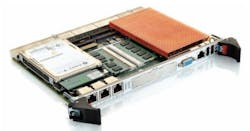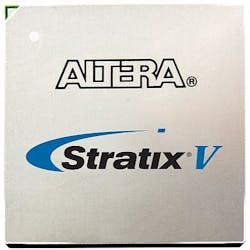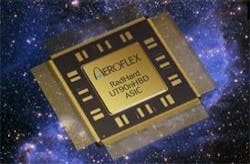Radiation-hardened electronics designers face increasing difficulty with shrinking chip geometries
Satellites thus have limited lifetimes due to radiation damage to components and as satellite semiconductor content and complexity grow the task of radiation-hardening is becoming more challenging, he continues.
Smaller feature sizes continue to challenge designers as they press to mitigate the effects of operating outside the atmosphere, Jordan says.
“With higher performing technologies come more radiation performance challenges,” says Vic Scuderi, manager of satellite electronics for BAE Systems in Manassas, Va.” “Feature size continues to shrink with an accompanying increase in susceptibility to damaging radiation effects. To mitigate these risks, our technology roadmaps have continued to blend rad-hard by design with rad-hard by process. We believe this blend is critical to designing space hardware that includes advanced application specific ICs (ASICs) manufactured at the 90, 65, or 45 nanometer technology nodes.”
“As technology evolves and feature sizes shrink, rad-hard is becoming more and more critical to overall space systems success,” says Doug Patterson, vice president of the military and aerospace business sector at Aitech in Chatsworth, Calif. “As far as standards go, total dose is only one aspect -- as systems get more integrated and demand more of technology, to ensure overall system reliability we have to address a class of radiation pathologies termed single event effects or SEEs. These include single event upsets, single event latchup, single event transients, single-event burnout, single-event gate rupture, etc. Suffice it to say, making components rad-hard is as challenging as ever.”
Users of power ICs such as those managed by International Rectifier in Calif., “are asking for higher radiation tolerance in terms of total ionizing dose (TID) and SEE when heritage data is not available, to improve the reliability and life of their systems,” says Odile Ronat, discrete marketing manager at International Rectifier. “Where 100 kilorad TID was sufficient, customers may now be asking for 300 kilorad. There are also requests for radiation levels beyond 1 megarad.”
Radiation and small components
Two different methods may be used deal with assuring radiation tolerance in relatively small components, say experts at a company called TRAD in Labege, France.
“For a given/frozen technology, electronic designers will try to obtain immune functions with a mitigation approach by using for example bit scrambling -- to randomize particle impact on different memory areas -- or appropriate error detection codes or even error correction codes -- with an error management/code size mitigation approach,” Chatry continues. “A basic complementary approach will consist in using redundant functions to prevent particle induced malfunctions.”
With regards to micro or nano technologies or MEMS (micro-electro-mechanical systems), “the challenge is at a different level,” Chatry says. “Hardening such technologies implies the investigation of new failure mechanisms and a new testing approach as compared to classical electronic components. Such small scale systems are generally mechanical and electrical systems -- i.e. micro switches, nano-valves -- which require specific physics.”
Chatry says that radiation assurance also needs to become a more collaborative process as components become more complex.
“The radiation assurance process has become more and more a multi-faceted activity requiring a collaborative approach between engineers of different fields,” Chatry says. “The Radiation Hardness Assurance (RHA) plan used in the space industry runs from the space environment calculation up to the estimate of the system response. This implies a strong partnership between different teams -- space and radiation environment, satellite design, particle-matter calculation, radiation modeling and calculation, electronics technologies, solid-state physics, radiation testing, electrical design, etc. The results of each group must be well understood by the others in order to ensure a coherent approach and to control the result uncertainties.”
Performance demands
Satellite and spacecraft designers much like their counterparts in avionics, vetronics, and shipboard systems want improved processor performance, greater memories, and low power in their systems.
Users of BAE Systems’ RAD750 single-board computer are demanding “more processing power, larger memories and EEPROM replacements,” which can make radiation hardening more complex, but they need the performance, Scuderi says.”We recently held a series of RAD750 Users Workshops at which we heard [that] loud and clear from our customers.”
They also “are looking for faster interfaces to get data into and out of the processor,” Scuderi continues. “Fortunately, this is the track we’ve been on and have products in development that address each of these needs. For example, we’re complementing the general purpose processing capabilities of the RAD750 with a high performance digital signal processor (DSP)” – the RADSPEED DSP, a radiation-hardened variant of the commercial CSX700 processor from ClearSpeed Technology in Oxford, England.
“This single instruction multiple Data (SIMD) machine features 152 processing elements each with double precision floating point units that are organized into two independent cores and achieves an estimated performance of 70 gigabit floating point operations per second,” he says. “This processor is well matched to applications such as image processing, radar processing, and spectral analysis.”
When it comes to the payload “it’s all about performance and power, i.e. image generation capability, target recognition and tracking, remote sensing, communication,” Aeroflex’s Jordan says. “Payload developers turn toward state of the art commercial technology for many of these systems to satisfy mission or business requirements.”
Performance vs. rad-hard
To achieve performance goals there are some tradeoffs happening, Jordan says. Payload developers trade traditional radiation hardened components for commercial products upscreened for their specific applications and mission.
“By understanding how a commercial integrated circuit reacts to the space environment, a payload developer is able to mitigate those effects via a number of system design techniques, Jordan says. “The performance requirements of many high profile missions and programs have resulted in the use of commercial parts, the community understands the additional due diligence requirements to increase the probability of success. It is an interesting dilemma for traditional radiation hardened suppliers.”
However, not all applications have the extreme radiation-hardening requirements of space programs.
Curtiss-Wright has a line of products for these applications called Rad-Hard Ready COTS (commercial-off-the-shelf), Slonosky says. The Rad-Hard Ready line does not look at being able to set aside rad-hard requirements, but is more about being rad-tolerant for applications where extreme rad-hard requirements are not necessary, he adds.
Curtiss-Wright tests their products at White Sands Missile Range, N.M., for gamma and neutron radiation, Slonosky says. The company’s rad-hard products are Curtiss-Wright COTS products that are modified so components are more rad-tolerant, he continues. For example some NOR flash devices are more rad-tolerant than others, he adds.
Some of these modified COTS products are flying in commercial human space flight applications where triple redundancy is built into the system to manage radiation assurance, he says. Using redundancy is less expensive than building radiation hardness directly into the card or component, he adds. This way they can get the performance of COTS, procured in a faster manner than developing a full-space qualified part, Slonosky says.
“COTS is still an interesting word, as it is equally misunderstood in the mil and aero markets just as it is for space,” Aitech’s Patterson says. “Military and space missions don’t fall in the domain of commercial. For example, your cell phone doesn’t have to mitigate SEEs, etc. That’s not to say however that we can’t utilize relevant COTS technology and in the end, that’s the real differentiator.
“At Aitech, we leverage the commercial sector’s development, and the billion-customer base testing of COTS technology to help guide us towards a viable solution for our military and space customers,” Patterson continues. “However, picking the chip is only the first step, that’s when the real work at the system-level just begins.”
Reconfiguring on orbit
Xilinx Inc. in San Jose, Calif., which offers commercial-grade FPGAs for space applications such as the ones used in Curtiss-Wright’s boards, is taking a different route with their new SRAM FPGA product – the V-5QVFX 130 FPGA -- that is full QML-certified qualified and geared for extreme radiation environments.
What has Xilinx excited though is that the FPGA can be reconfigured while in orbit,” says John Bendekovic, director of aerospace and defense sales at Xilinx in San Jose, Calif. This is the first viable, in-production rad-hard FPGA that has that capability, he adds.
Spacecraft that in orbit for as long as 15 years do not have the ability to upgrade during that time, he says. It enables satellite designers to no longer worry about anticipating changes and fixes to sensor interfaces, payloads, or processor structures, he says. “Now designers can make changes just by uploading code,” Bendekovic continues.
The device– based on the Xilinx Virtex V FPGA -- is radiation-hardened by design, Bendekovic says. “It is unique because we went in and addressed the vulnerabilities through redesign.”
Rad-hard offerings
Aeroflex Colorado Springs is under contract to leverage prior government funding with the Boeing Solid State Electronics Division (SSED) in Kent, Wash., to bring a 90 nanometer Radhard-by-Design (RHBD) library into the main stream, says Peter Milliken, director of semicustom products at Aeroflex Colorado Springs. The 90-nanometer library offers high-speed SerDes (3 1/8 gigabits per second), high performance embedded compiled memory (400 to 500 megahertz) and is capable of delivering ASICs with more than 30 million gates of logic.
International Rectifier in Redmond, Wash., is seeing requests for use of ceramic lids instead of metal lids in cases of X-Ray threat, Ronat says. The company introduced the ceramic lid options on several of its surface mount packages including LCC-3 and SMD0.2 as options for applications susceptible to X-Ray threat.
Microelectronics officials of the U.S. Department of Defense (DOD) have certified Microsemi Corp. in Irvine, Calif., to build radiation-hardened microelectronics assemblies for space and mission-critical defense programs by granting the company MIL-PRF-38534 class H and K certifications. The MIL-PRF-38534 standard pertains to manufacturing quality based on statistical process control. Class H and K rad-hard certifications under MIL-PRF-38534 pertain to certain classes of resistance to the effects of radiation.
“Aitech currently offer the world’s first, space-rated, six-port Gigabit Ethernet managed switch called the S750, Patterson says. “The S750 implements and provides a built-in network interface card in a 3U CompactPCI PMC conduction-cooled form factor.”
Company listing
Aeroflex
Colorado Springs, Colo.
www.aeroflex.com
Aitech
Chatsworth, Calif.
www.rugged.com
ASIC Advantage
Sunnyvale, Calif.
www.asicadvantage.com
Atmel
San Jose, Calif.
www.atmel.com
BAE Systems Electronic Solutions
Manassas, Va.
www.baesystems.com
C-MAC Micro Technology
Buckinghamshire, United Kingdom
www.cmac.com
Crane Interpoint
Redmond, Wash.
www.interpoint.com
Curtiss-Wright Controls Embedded Computing
Ashburn, Va.
www.cwcembedded.com
Harris
Melbourne, Fla.
www.harris.com
Honeywell Microelectronics
Plymouth, Minn.
www.honeywellmicroelectronics.com
International Rectifier
El Segundo, Calif.
www.irf.com
Intersil Corp.
Milpitas, Calif.
www.intersil.com
Linear Technology Corp.
Milpitas, Calif.
www.linear.com
Maxwell Technologies
San Diego, Calif.
www.maxwell.com
Microelectronics Research Development Corp.
Colorado Springs, Colo.
www.micro-rdc.com
Micropac Industries
Garland, Texas
www.micropac.com
Microsemi
Mountain View, Calif.
www.actel.com
Modular Devices
Shirley, N.Y.
www.mdipower.com
MS Kennedy
Liverpool, N.Y.
www.mskennedy.com
Peregrine Semiconductor Corp.
San Diego, Calif.
www.psemi.com
Radiation Assured Devices
Colorado Springs, Colo.
radiationassureddevices.com/index.html
Semicoa
Costa Mesa, Calif.
www.semicoa.com
STMicroelectronics
Geneva, Switzerland
www.st.com
Synova
Melbourne, Fla.
www.synova.com
Teledyne Microelectronic Technologies
Los Angeles, Calif.
www.teledynemicro.com
Texas Instruments
Dallas, Texas
www.ti.com
3D-Plus
McKinney, Texas
www.3d-plus.com
TRAD
Lebarge, France
www.trad.fr
Triad Semiconductor
Winston-Salem, N.C.
www.triadsemi.com
Ultra Communications
Vista, Calif.
www.ultracomm-inc.com
VPT
Everett, Wash.
www.vpt-inc.com
Xilinx
San Jose, Calif.
www.xilinx.com



